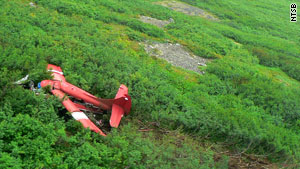More on the crash, with some commentary, from the
New York Times
JUNEAU, Alaska (AP) — The plane that crashed into an Alaskan mountainside and killed former Senator Ted Stevens of Alaska and four others was equipped with an alert system that warned pilots of dangerous terrain.
But the National Transportation Safety Board chairwoman, Deborah Hersman, said it was not known whether the system was working.
There is more than one terrain avoidance system, and without further information I can have no additional comment. But yes, whether or not it was working is an interesting question. I'd be curious if survivors had heard a warning sound of some sort or not. It is possible that such a sound, while audible to the pilot and those up front, may not have been audible to those in the back of the airplane. The same would apply to any visual warning that may have been used. If the survivors were all in the rear of the airplane it might have alerted but they might also have been unaware of it.
The plane, which crashed on Monday, was also equipped with an emergency locator transmitter, Ms. Hersman said at a news conference in Anchorage on Friday. When properly registered, it issues a distress signal to a control center via satellite and provides registration information. Ms. Hersman said it was unclear why that signal did not activate.
This is a badly written paragraph and clearing the reporter did not fully understand the information related. The Emergency Locator Transmitter or ELT does not need to be "registered". It
does need to be properly set. These are checked on a regular basis and mandatory on all airplanes having more than one seat (even single seaters normally have them, even if not required). They are activated by a either an impact greater than a set number of g's, or by manually flipping a switch. If the impact was under the required threshold it would not go off. That is why there is a manual switch, so that if you have a "gentle" crash survivors can manually activate it to summon help. It may be none of the survivors knew this, or knew how to activate it. Give the shallow angle of impact, it may simply be that the impact was not sufficient to trigger it and no one left alive knew how to use it. Also, ELT's are most commonly located in the tail of the airplane (that being the area most likely to survive) and as one can see from the picture the front of the airplane absorbed a lot of the impact. Again, this may have reduced the g's forces on the ELT to less than the triggering amount.
The five victims died from blunt-force trauma, said Dr. Katherine Raven, the state medical examiner. Four people survived, and investigators interviewed two of them on Friday.
Ms. Hersman told reporters that one of the survivors described the crash by saying, “They were flying along, and they just stopped flying.”
The same survivor said he did not notice any changes in the plane’s pitch or hear any unusual engine sounds in the moments before the plane went down, about 20 miles north of Dillingham in southwest Alaska.
This is starting to sound like CFIT or "controlled flight into terrain". The visibility at time of take off was reported as 3 miles (5 km) under an overcast at 2,000 feet (600 m). These are marginal conditions for visual flight rules or VFR,
especially in mountainous areas where the terrain abruptly changes in altitude. Which is the sort of area they were in. Now, the pilot was instrument rated, and I'm sure the airplane in question had at least the minimal instrument required for flight in instrument meteorological conditions or IFR. HOWEVER - Alaska is in many ways remote and wild. The navigational beacons and other instruments required for
safe IFR flights are few and far between. Hence, nearly all bush flying (and this was flying in the bush) is done under VFR even if the pilot is IFR trained and the airplane is IFR equipped for the simple reason that the ground-based components necessary are missing. Yes, GPS can get around this - IF the airplane has a GPS system rated for IFR (actually, pretty common these days) and IF they can pick up enough GPS satellites for reliable information. That sort of satellite coverage doesn't always happen in Alaska, and weather and terrain that blocks signals can also be a factor. I don't think the weather was that bad (it has to be REALLY horrific weather) but the terrain might have particularly if the satellites available were all near the horizon relative to the airplane.
So... did they file a flight plan? If they filed one, that tells us if they had planned to fly IFR or VFR (which was just barely legal under those conditions, but most pilots would consider such conditions hazardous to fly VFR even on flat terrain where I live, much less in the mountains). If they did not file a flight plan (perfectly legal in the US under those conditions) then they were flying VFR.
If they were flying VFR it is entirely possible that they simply didn't see the mountainside until it was too late to avoid it. Which is why VFR flight in marginal conditions in the mountains is considered hazardous, even if it is legal.
Ms. Hersman did not identify the survivors who spoke.
The survivors are Sean O’Keefe, a former National Aeronautics and Space Administration chief; his son, Kevin; a lobbyist, James Morhard; and William Phillips Jr., 13.
An Anchorage hospital on Friday upgraded the condition of Mr. O’Keefe from critical to serious. Kevin O’Keefe and Mr. Morhard were in fair condition, and Mr. Phillips was in good condition.
Besides Mr. Stevens, the victims were Theron Smith, the pilot; Dana Tindall, an executive of General Communications Inc.; Mr. Tindall’s 16-year-old daughter, Corey; and William Phillips Sr., who had worked with Mr. Stevens in Washington.
One survivor said the group decided over lunch at a lodge owned by General Communications to head to a fishing camp, Ms. Hersman said, a trip that had been put off in the morning because of poor weather.
Pity they didn't put it off still longer.
The survivor said conditions had improved by the afternoon. He said he fell asleep about 10 to 15 minutes into the flight and woke up after the crash, Ms. Hersman said.
David Morris, a spokesman for General Communications, said about 13 people originally arrived at the lodge on Aug. 7 for what was “primarily a Stevens trip.”
Mr. Smith was a temporary replacement for the regular pilot, who had unexpectedly quit, Mr. Morris said. Mr. Smith was a longtime pilot for Alaska Airlines, retiring in 2007 after 28 years, and was qualified to fly the float plane and to fly in that part of the country, Mr. Morris said.
Ms. Hersman said Mr. Smith was estimated to have had 10 hours of air time in the float plane that crashed and 35 hours in the same type of plane. He had thousands of hours in both single- and dual-engine amphibious aircraft.
While that's not a lot of hours for a particular type of airplane it is sufficient to be considered competent to fly an Otter. Of more importance was the "thousands of hour in both single and dual engine amphibious aircraft" as well as his professional experience. This was a
very experience, and presumably skilled, pilot who crashed.
Ms. Hersman said Mr. Smith did not request a weather briefing before departure. However, investigators have been told there was Internet service at the camp, and he may have checked conditions that way.
OK, let me mention something about weather briefings. During the Bush years, the weather briefing stations were consolidated and outsourced to a private company, and many closed in the name of efficiency. It turned what used to be either a direct line to trained human meteorologist familiar with your general region, or maybe a 2-3 minute on hold time into a 20-30 minute wait on hold to a harried briefer who was under pressure to get you off the phone quickly who might never have been in your area, is thousands of kilometers away, and basically not able to provide the prior in-depth service available from the government briefers. In other words, this was a case where the government WAS doing it right and the conservitards fucked it up in order to save some pennies, because saving money is more important than safety Not that I'm
bitter or anything.... Anyhow. The upshot is that with more and more weather information available on-line, and frequently as good as what the briefers are looking at, and available instantly at a keyboard, more and more pilots are opting to get their own weather information and not use the briefers (well, yeah, I guess that
does save money for someone). Problem is, in the old days, if you were about to do something dumb (like VFR flight in low visibility in the mountains) the briefers would say "VFR flight not advised" or even "Are you
sure you want to do that?" And we know, because these conservations are monitored, that there were times pilots said "Right, that's not a good idea, I'm staying on the ground" (In fact,
I've said that a couple times when talking to weather briefers.) With the internet, there's no human standing there to say "Hey, re-think this a minute". Also, back when almost all pilots used human weather briefer we could have some idea of what a pilot was or wasn't told before an accident - we
can't know that anymore. We can't even know if they checked the weather.
So - we
know the pilot in this case did not call Flight Service to talk to a human weather briefer. We know nothing else about what he might or might not have checked prior to flight.
I will also note that it is almost a certainty that the airplane contained no form of black box, and they are not normally installed on that size of airplane.







